EU-US Beef Dispute: A Critical Analysis of Trade and Regulations
VerifiedAdded on 2022/09/26
|8
|2219
|24
Report
AI Summary
This report provides a comprehensive analysis of the long-running EU-US dispute concerning the exportation of U.S. beef, focusing on the use of hormones. It explores the origins of the disagreement, which dates back to the 1980s, and the scientific evidence supporting the EU's ban on hormone-treated beef, particularly the concerns regarding potential health risks like cancer. The report delves into the risk analysis conducted and the dispute settlement processes, including the involvement of the WTO and various negotiation attempts. It examines the trade sanctions imposed by both sides, including the U.S.'s retaliatory tariffs. The report concludes by discussing the current status of the dispute and the ongoing efforts to find a resolution, highlighting the economic impacts and the need for a sustainable solution that addresses the concerns of both parties and facilitates free trade. The analysis includes a critical review of the key documents and the impact on various stakeholders.
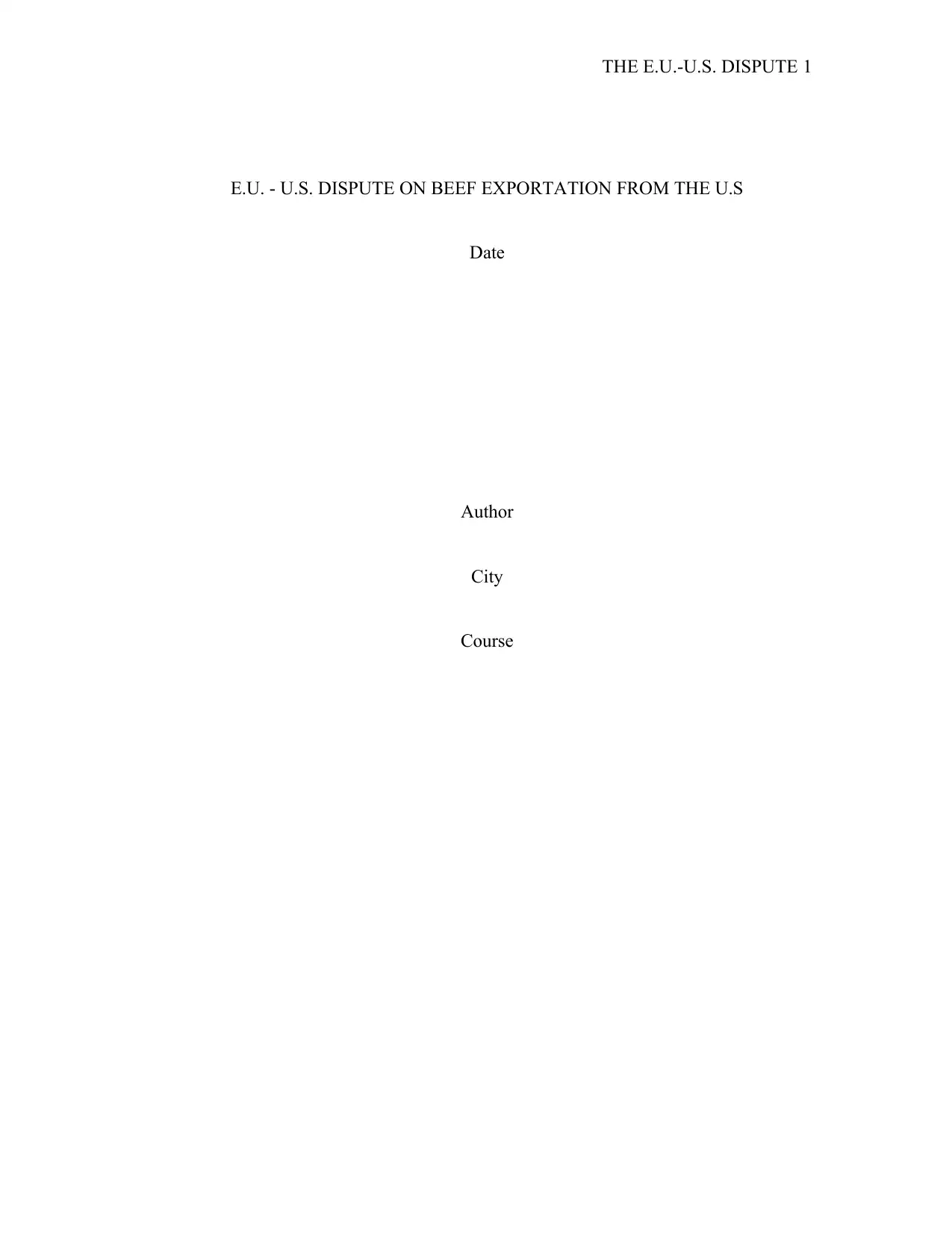
THE E.U.-U.S. DISPUTE 1
E.U. - U.S. DISPUTE ON BEEF EXPORTATION FROM THE U.S
Date
Author
City
Course
E.U. - U.S. DISPUTE ON BEEF EXPORTATION FROM THE U.S
Date
Author
City
Course
Paraphrase This Document
Need a fresh take? Get an instant paraphrase of this document with our AI Paraphraser
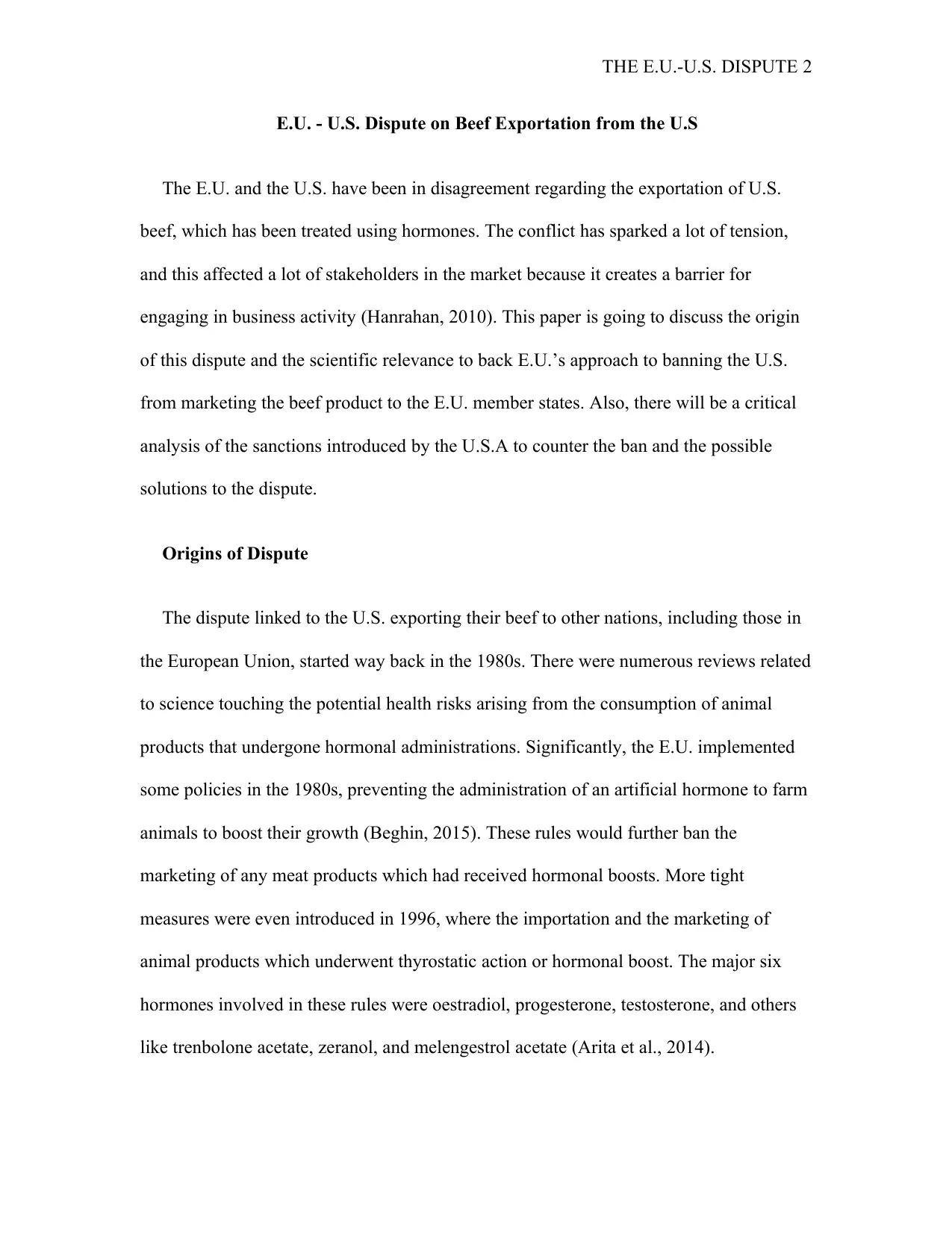
THE E.U.-U.S. DISPUTE 2
E.U. - U.S. Dispute on Beef Exportation from the U.S
The E.U. and the U.S. have been in disagreement regarding the exportation of U.S.
beef, which has been treated using hormones. The conflict has sparked a lot of tension,
and this affected a lot of stakeholders in the market because it creates a barrier for
engaging in business activity (Hanrahan, 2010). This paper is going to discuss the origin
of this dispute and the scientific relevance to back E.U.’s approach to banning the U.S.
from marketing the beef product to the E.U. member states. Also, there will be a critical
analysis of the sanctions introduced by the U.S.A to counter the ban and the possible
solutions to the dispute.
Origins of Dispute
The dispute linked to the U.S. exporting their beef to other nations, including those in
the European Union, started way back in the 1980s. There were numerous reviews related
to science touching the potential health risks arising from the consumption of animal
products that undergone hormonal administrations. Significantly, the E.U. implemented
some policies in the 1980s, preventing the administration of an artificial hormone to farm
animals to boost their growth (Beghin, 2015). These rules would further ban the
marketing of any meat products which had received hormonal boosts. More tight
measures were even introduced in 1996, where the importation and the marketing of
animal products which underwent thyrostatic action or hormonal boost. The major six
hormones involved in these rules were oestradiol, progesterone, testosterone, and others
like trenbolone acetate, zeranol, and melengestrol acetate (Arita et al., 2014).
E.U. - U.S. Dispute on Beef Exportation from the U.S
The E.U. and the U.S. have been in disagreement regarding the exportation of U.S.
beef, which has been treated using hormones. The conflict has sparked a lot of tension,
and this affected a lot of stakeholders in the market because it creates a barrier for
engaging in business activity (Hanrahan, 2010). This paper is going to discuss the origin
of this dispute and the scientific relevance to back E.U.’s approach to banning the U.S.
from marketing the beef product to the E.U. member states. Also, there will be a critical
analysis of the sanctions introduced by the U.S.A to counter the ban and the possible
solutions to the dispute.
Origins of Dispute
The dispute linked to the U.S. exporting their beef to other nations, including those in
the European Union, started way back in the 1980s. There were numerous reviews related
to science touching the potential health risks arising from the consumption of animal
products that undergone hormonal administrations. Significantly, the E.U. implemented
some policies in the 1980s, preventing the administration of an artificial hormone to farm
animals to boost their growth (Beghin, 2015). These rules would further ban the
marketing of any meat products which had received hormonal boosts. More tight
measures were even introduced in 1996, where the importation and the marketing of
animal products which underwent thyrostatic action or hormonal boost. The major six
hormones involved in these rules were oestradiol, progesterone, testosterone, and others
like trenbolone acetate, zeranol, and melengestrol acetate (Arita et al., 2014).
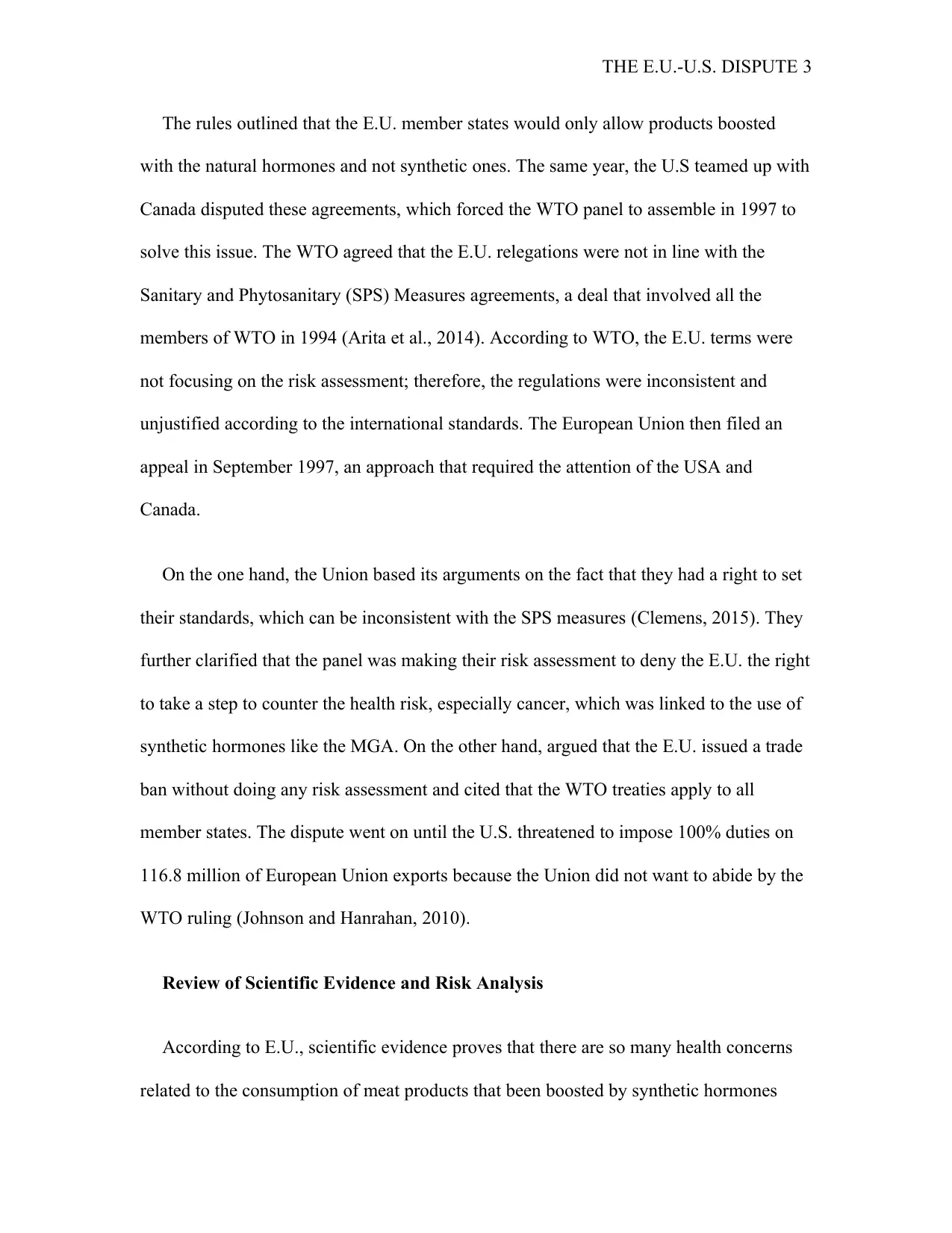
THE E.U.-U.S. DISPUTE 3
The rules outlined that the E.U. member states would only allow products boosted
with the natural hormones and not synthetic ones. The same year, the U.S teamed up with
Canada disputed these agreements, which forced the WTO panel to assemble in 1997 to
solve this issue. The WTO agreed that the E.U. relegations were not in line with the
Sanitary and Phytosanitary (SPS) Measures agreements, a deal that involved all the
members of WTO in 1994 (Arita et al., 2014). According to WTO, the E.U. terms were
not focusing on the risk assessment; therefore, the regulations were inconsistent and
unjustified according to the international standards. The European Union then filed an
appeal in September 1997, an approach that required the attention of the USA and
Canada.
On the one hand, the Union based its arguments on the fact that they had a right to set
their standards, which can be inconsistent with the SPS measures (Clemens, 2015). They
further clarified that the panel was making their risk assessment to deny the E.U. the right
to take a step to counter the health risk, especially cancer, which was linked to the use of
synthetic hormones like the MGA. On the other hand, argued that the E.U. issued a trade
ban without doing any risk assessment and cited that the WTO treaties apply to all
member states. The dispute went on until the U.S. threatened to impose 100% duties on
116.8 million of European Union exports because the Union did not want to abide by the
WTO ruling (Johnson and Hanrahan, 2010).
Review of Scientific Evidence and Risk Analysis
According to E.U., scientific evidence proves that there are so many health concerns
related to the consumption of meat products that been boosted by synthetic hormones
The rules outlined that the E.U. member states would only allow products boosted
with the natural hormones and not synthetic ones. The same year, the U.S teamed up with
Canada disputed these agreements, which forced the WTO panel to assemble in 1997 to
solve this issue. The WTO agreed that the E.U. relegations were not in line with the
Sanitary and Phytosanitary (SPS) Measures agreements, a deal that involved all the
members of WTO in 1994 (Arita et al., 2014). According to WTO, the E.U. terms were
not focusing on the risk assessment; therefore, the regulations were inconsistent and
unjustified according to the international standards. The European Union then filed an
appeal in September 1997, an approach that required the attention of the USA and
Canada.
On the one hand, the Union based its arguments on the fact that they had a right to set
their standards, which can be inconsistent with the SPS measures (Clemens, 2015). They
further clarified that the panel was making their risk assessment to deny the E.U. the right
to take a step to counter the health risk, especially cancer, which was linked to the use of
synthetic hormones like the MGA. On the other hand, argued that the E.U. issued a trade
ban without doing any risk assessment and cited that the WTO treaties apply to all
member states. The dispute went on until the U.S. threatened to impose 100% duties on
116.8 million of European Union exports because the Union did not want to abide by the
WTO ruling (Johnson and Hanrahan, 2010).
Review of Scientific Evidence and Risk Analysis
According to E.U., scientific evidence proves that there are so many health concerns
related to the consumption of meat products that been boosted by synthetic hormones
⊘ This is a preview!⊘
Do you want full access?
Subscribe today to unlock all pages.

Trusted by 1+ million students worldwide
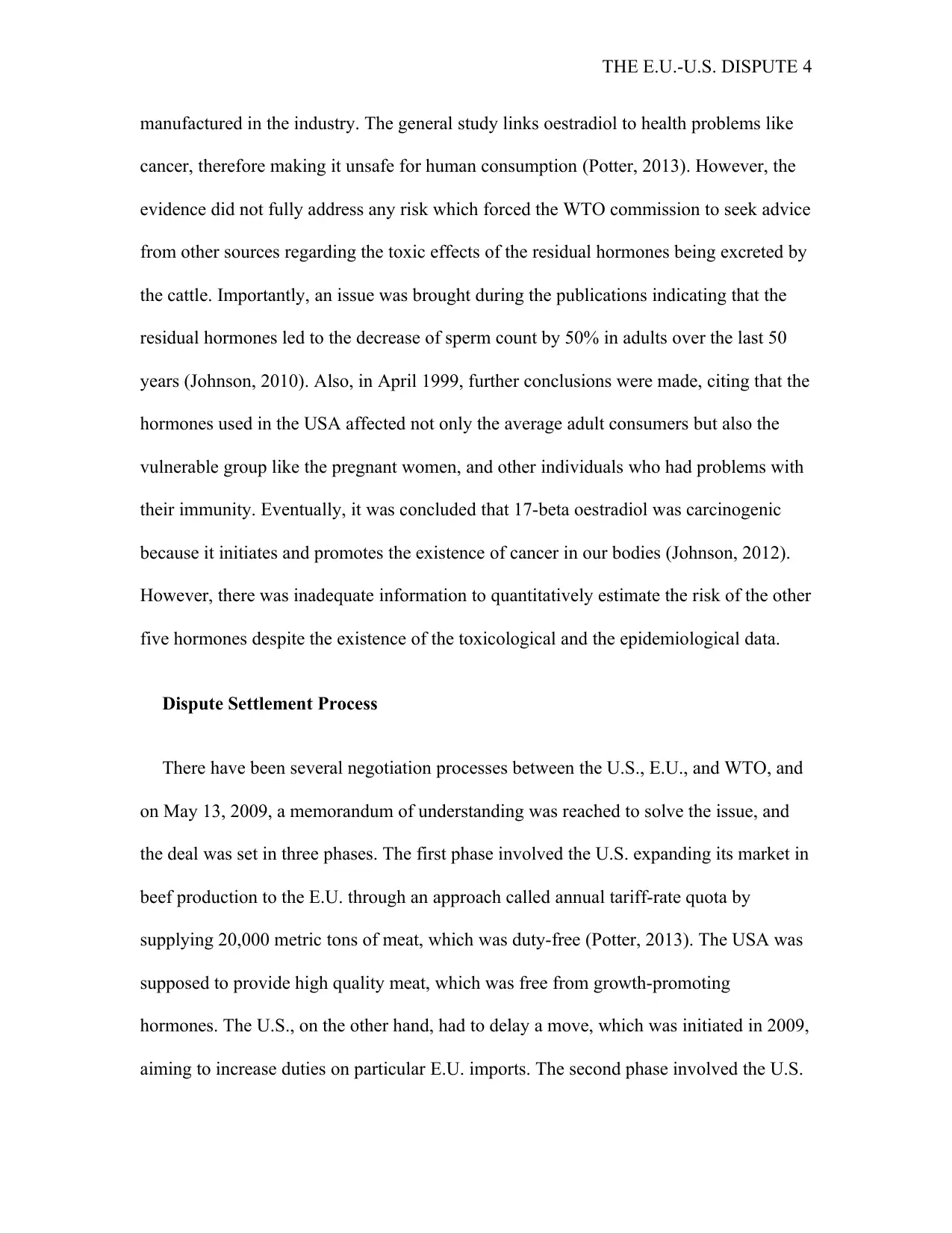
THE E.U.-U.S. DISPUTE 4
manufactured in the industry. The general study links oestradiol to health problems like
cancer, therefore making it unsafe for human consumption (Potter, 2013). However, the
evidence did not fully address any risk which forced the WTO commission to seek advice
from other sources regarding the toxic effects of the residual hormones being excreted by
the cattle. Importantly, an issue was brought during the publications indicating that the
residual hormones led to the decrease of sperm count by 50% in adults over the last 50
years (Johnson, 2010). Also, in April 1999, further conclusions were made, citing that the
hormones used in the USA affected not only the average adult consumers but also the
vulnerable group like the pregnant women, and other individuals who had problems with
their immunity. Eventually, it was concluded that 17-beta oestradiol was carcinogenic
because it initiates and promotes the existence of cancer in our bodies (Johnson, 2012).
However, there was inadequate information to quantitatively estimate the risk of the other
five hormones despite the existence of the toxicological and the epidemiological data.
Dispute Settlement Process
There have been several negotiation processes between the U.S., E.U., and WTO, and
on May 13, 2009, a memorandum of understanding was reached to solve the issue, and
the deal was set in three phases. The first phase involved the U.S. expanding its market in
beef production to the E.U. through an approach called annual tariff-rate quota by
supplying 20,000 metric tons of meat, which was duty-free (Potter, 2013). The USA was
supposed to provide high quality meat, which was free from growth-promoting
hormones. The U.S., on the other hand, had to delay a move, which was initiated in 2009,
aiming to increase duties on particular E.U. imports. The second phase involved the U.S.
manufactured in the industry. The general study links oestradiol to health problems like
cancer, therefore making it unsafe for human consumption (Potter, 2013). However, the
evidence did not fully address any risk which forced the WTO commission to seek advice
from other sources regarding the toxic effects of the residual hormones being excreted by
the cattle. Importantly, an issue was brought during the publications indicating that the
residual hormones led to the decrease of sperm count by 50% in adults over the last 50
years (Johnson, 2010). Also, in April 1999, further conclusions were made, citing that the
hormones used in the USA affected not only the average adult consumers but also the
vulnerable group like the pregnant women, and other individuals who had problems with
their immunity. Eventually, it was concluded that 17-beta oestradiol was carcinogenic
because it initiates and promotes the existence of cancer in our bodies (Johnson, 2012).
However, there was inadequate information to quantitatively estimate the risk of the other
five hormones despite the existence of the toxicological and the epidemiological data.
Dispute Settlement Process
There have been several negotiation processes between the U.S., E.U., and WTO, and
on May 13, 2009, a memorandum of understanding was reached to solve the issue, and
the deal was set in three phases. The first phase involved the U.S. expanding its market in
beef production to the E.U. through an approach called annual tariff-rate quota by
supplying 20,000 metric tons of meat, which was duty-free (Potter, 2013). The USA was
supposed to provide high quality meat, which was free from growth-promoting
hormones. The U.S., on the other hand, had to delay a move, which was initiated in 2009,
aiming to increase duties on particular E.U. imports. The second phase involved the U.S.
Paraphrase This Document
Need a fresh take? Get an instant paraphrase of this document with our AI Paraphraser
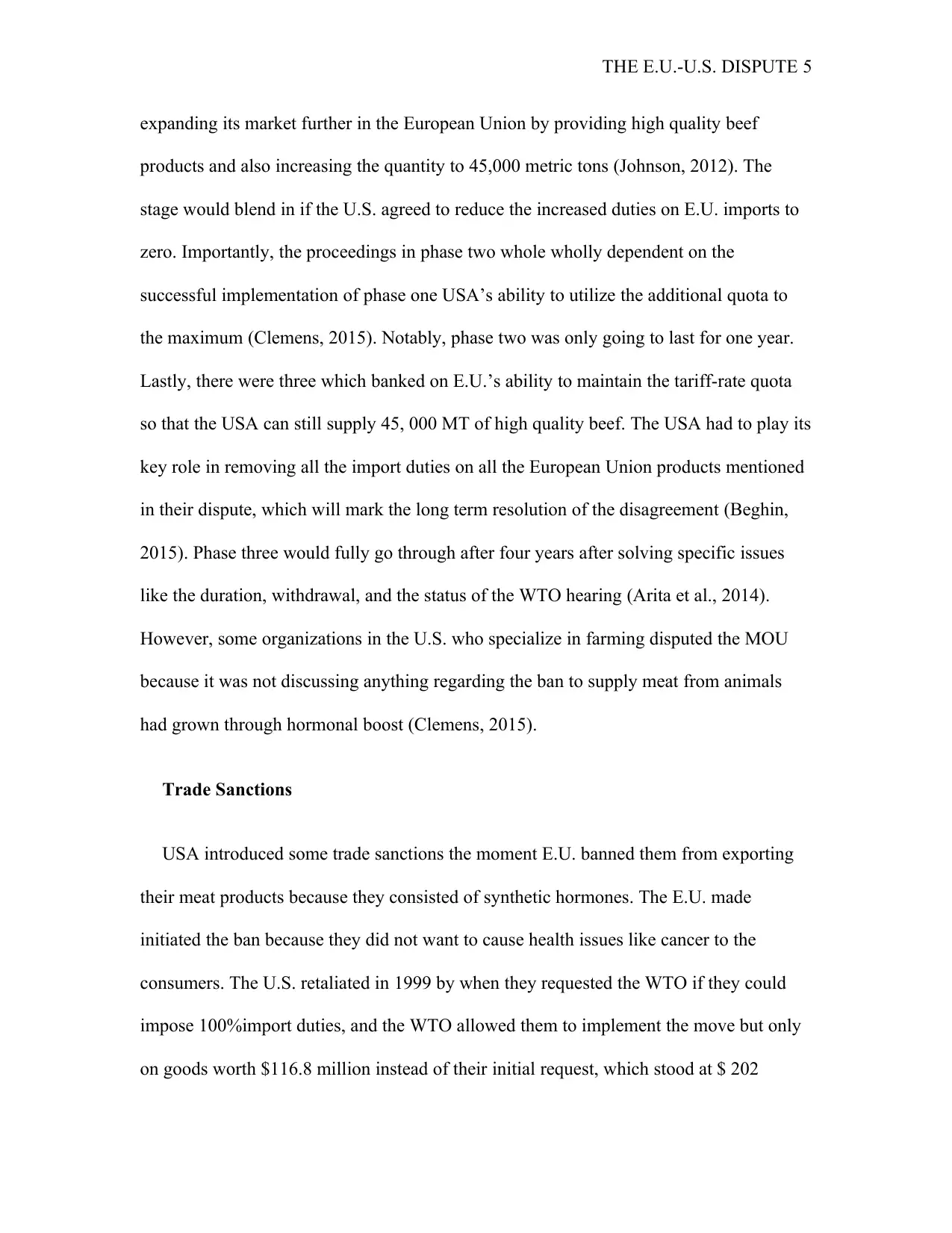
THE E.U.-U.S. DISPUTE 5
expanding its market further in the European Union by providing high quality beef
products and also increasing the quantity to 45,000 metric tons (Johnson, 2012). The
stage would blend in if the U.S. agreed to reduce the increased duties on E.U. imports to
zero. Importantly, the proceedings in phase two whole wholly dependent on the
successful implementation of phase one USA’s ability to utilize the additional quota to
the maximum (Clemens, 2015). Notably, phase two was only going to last for one year.
Lastly, there were three which banked on E.U.’s ability to maintain the tariff-rate quota
so that the USA can still supply 45, 000 MT of high quality beef. The USA had to play its
key role in removing all the import duties on all the European Union products mentioned
in their dispute, which will mark the long term resolution of the disagreement (Beghin,
2015). Phase three would fully go through after four years after solving specific issues
like the duration, withdrawal, and the status of the WTO hearing (Arita et al., 2014).
However, some organizations in the U.S. who specialize in farming disputed the MOU
because it was not discussing anything regarding the ban to supply meat from animals
had grown through hormonal boost (Clemens, 2015).
Trade Sanctions
USA introduced some trade sanctions the moment E.U. banned them from exporting
their meat products because they consisted of synthetic hormones. The E.U. made
initiated the ban because they did not want to cause health issues like cancer to the
consumers. The U.S. retaliated in 1999 by when they requested the WTO if they could
impose 100%import duties, and the WTO allowed them to implement the move but only
on goods worth $116.8 million instead of their initial request, which stood at $ 202
expanding its market further in the European Union by providing high quality beef
products and also increasing the quantity to 45,000 metric tons (Johnson, 2012). The
stage would blend in if the U.S. agreed to reduce the increased duties on E.U. imports to
zero. Importantly, the proceedings in phase two whole wholly dependent on the
successful implementation of phase one USA’s ability to utilize the additional quota to
the maximum (Clemens, 2015). Notably, phase two was only going to last for one year.
Lastly, there were three which banked on E.U.’s ability to maintain the tariff-rate quota
so that the USA can still supply 45, 000 MT of high quality beef. The USA had to play its
key role in removing all the import duties on all the European Union products mentioned
in their dispute, which will mark the long term resolution of the disagreement (Beghin,
2015). Phase three would fully go through after four years after solving specific issues
like the duration, withdrawal, and the status of the WTO hearing (Arita et al., 2014).
However, some organizations in the U.S. who specialize in farming disputed the MOU
because it was not discussing anything regarding the ban to supply meat from animals
had grown through hormonal boost (Clemens, 2015).
Trade Sanctions
USA introduced some trade sanctions the moment E.U. banned them from exporting
their meat products because they consisted of synthetic hormones. The E.U. made
initiated the ban because they did not want to cause health issues like cancer to the
consumers. The U.S. retaliated in 1999 by when they requested the WTO if they could
impose 100%import duties, and the WTO allowed them to implement the move but only
on goods worth $116.8 million instead of their initial request, which stood at $ 202
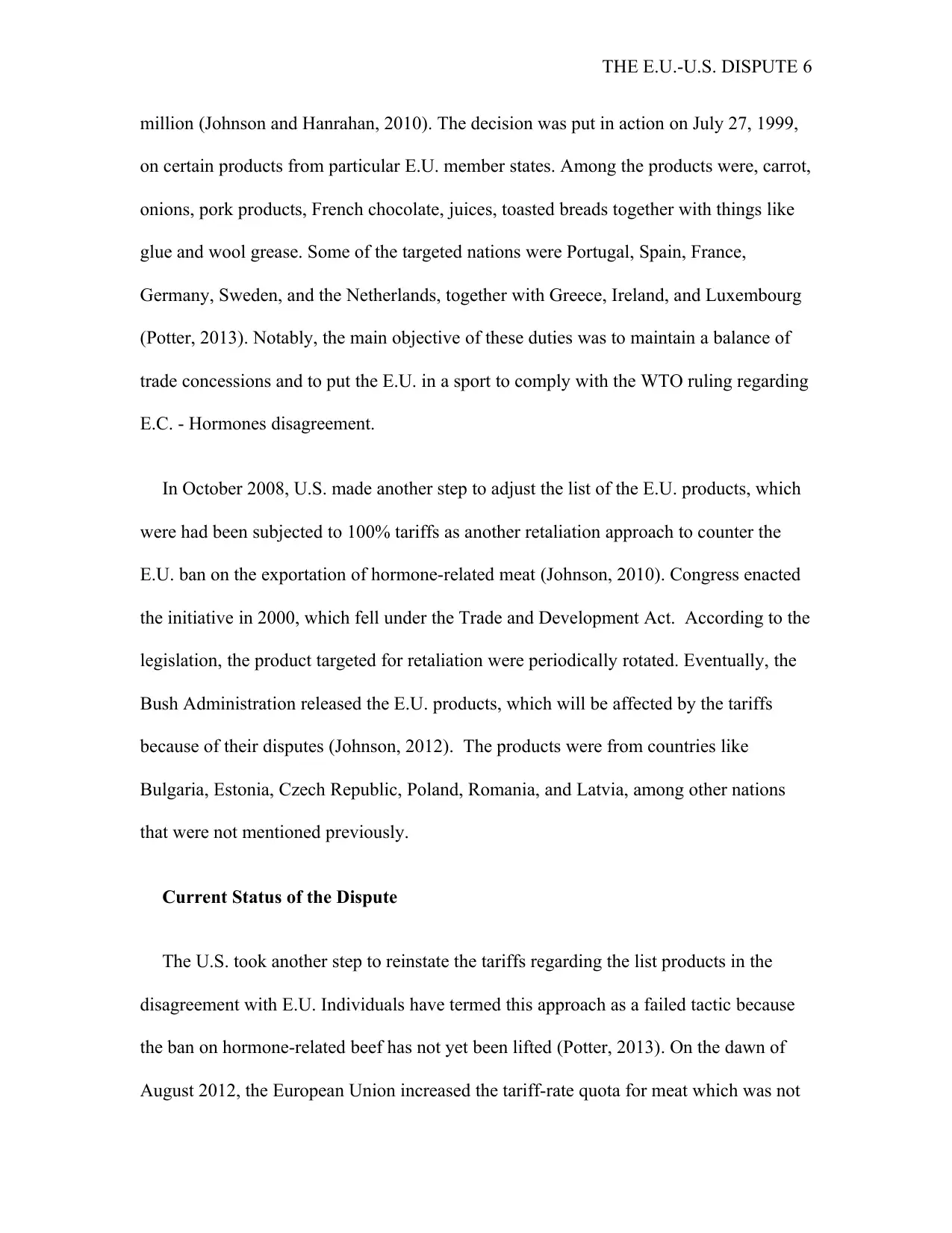
THE E.U.-U.S. DISPUTE 6
million (Johnson and Hanrahan, 2010). The decision was put in action on July 27, 1999,
on certain products from particular E.U. member states. Among the products were, carrot,
onions, pork products, French chocolate, juices, toasted breads together with things like
glue and wool grease. Some of the targeted nations were Portugal, Spain, France,
Germany, Sweden, and the Netherlands, together with Greece, Ireland, and Luxembourg
(Potter, 2013). Notably, the main objective of these duties was to maintain a balance of
trade concessions and to put the E.U. in a sport to comply with the WTO ruling regarding
E.C. - Hormones disagreement.
In October 2008, U.S. made another step to adjust the list of the E.U. products, which
were had been subjected to 100% tariffs as another retaliation approach to counter the
E.U. ban on the exportation of hormone-related meat (Johnson, 2010). Congress enacted
the initiative in 2000, which fell under the Trade and Development Act. According to the
legislation, the product targeted for retaliation were periodically rotated. Eventually, the
Bush Administration released the E.U. products, which will be affected by the tariffs
because of their disputes (Johnson, 2012). The products were from countries like
Bulgaria, Estonia, Czech Republic, Poland, Romania, and Latvia, among other nations
that were not mentioned previously.
Current Status of the Dispute
The U.S. took another step to reinstate the tariffs regarding the list products in the
disagreement with E.U. Individuals have termed this approach as a failed tactic because
the ban on hormone-related beef has not yet been lifted (Potter, 2013). On the dawn of
August 2012, the European Union increased the tariff-rate quota for meat which was not
million (Johnson and Hanrahan, 2010). The decision was put in action on July 27, 1999,
on certain products from particular E.U. member states. Among the products were, carrot,
onions, pork products, French chocolate, juices, toasted breads together with things like
glue and wool grease. Some of the targeted nations were Portugal, Spain, France,
Germany, Sweden, and the Netherlands, together with Greece, Ireland, and Luxembourg
(Potter, 2013). Notably, the main objective of these duties was to maintain a balance of
trade concessions and to put the E.U. in a sport to comply with the WTO ruling regarding
E.C. - Hormones disagreement.
In October 2008, U.S. made another step to adjust the list of the E.U. products, which
were had been subjected to 100% tariffs as another retaliation approach to counter the
E.U. ban on the exportation of hormone-related meat (Johnson, 2010). Congress enacted
the initiative in 2000, which fell under the Trade and Development Act. According to the
legislation, the product targeted for retaliation were periodically rotated. Eventually, the
Bush Administration released the E.U. products, which will be affected by the tariffs
because of their disputes (Johnson, 2012). The products were from countries like
Bulgaria, Estonia, Czech Republic, Poland, Romania, and Latvia, among other nations
that were not mentioned previously.
Current Status of the Dispute
The U.S. took another step to reinstate the tariffs regarding the list products in the
disagreement with E.U. Individuals have termed this approach as a failed tactic because
the ban on hormone-related beef has not yet been lifted (Potter, 2013). On the dawn of
August 2012, the European Union increased the tariff-rate quota for meat which was not
⊘ This is a preview!⊘
Do you want full access?
Subscribe today to unlock all pages.

Trusted by 1+ million students worldwide
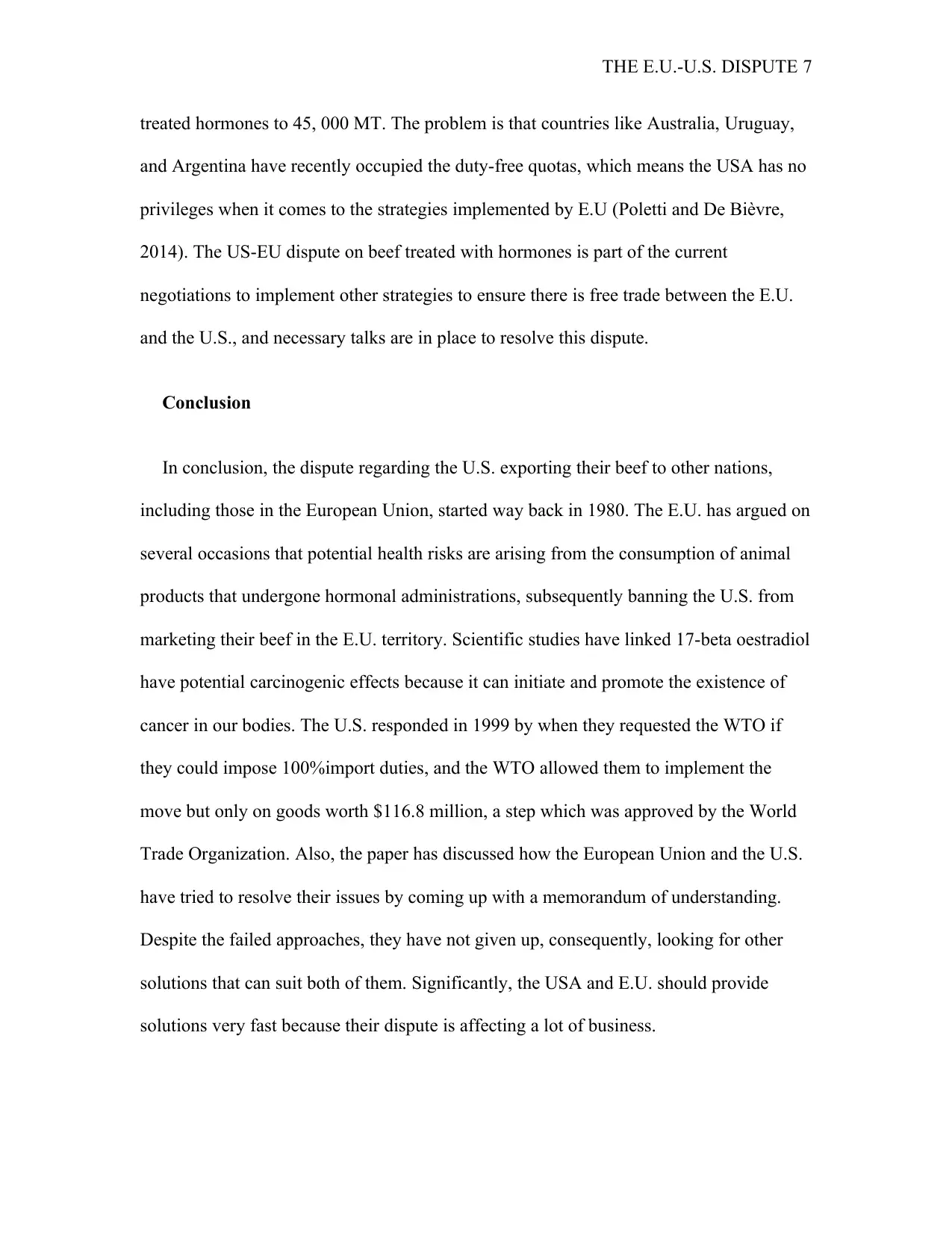
THE E.U.-U.S. DISPUTE 7
treated hormones to 45, 000 MT. The problem is that countries like Australia, Uruguay,
and Argentina have recently occupied the duty-free quotas, which means the USA has no
privileges when it comes to the strategies implemented by E.U (Poletti and De Bièvre,
2014). The US-EU dispute on beef treated with hormones is part of the current
negotiations to implement other strategies to ensure there is free trade between the E.U.
and the U.S., and necessary talks are in place to resolve this dispute.
Conclusion
In conclusion, the dispute regarding the U.S. exporting their beef to other nations,
including those in the European Union, started way back in 1980. The E.U. has argued on
several occasions that potential health risks are arising from the consumption of animal
products that undergone hormonal administrations, subsequently banning the U.S. from
marketing their beef in the E.U. territory. Scientific studies have linked 17-beta oestradiol
have potential carcinogenic effects because it can initiate and promote the existence of
cancer in our bodies. The U.S. responded in 1999 by when they requested the WTO if
they could impose 100%import duties, and the WTO allowed them to implement the
move but only on goods worth $116.8 million, a step which was approved by the World
Trade Organization. Also, the paper has discussed how the European Union and the U.S.
have tried to resolve their issues by coming up with a memorandum of understanding.
Despite the failed approaches, they have not given up, consequently, looking for other
solutions that can suit both of them. Significantly, the USA and E.U. should provide
solutions very fast because their dispute is affecting a lot of business.
treated hormones to 45, 000 MT. The problem is that countries like Australia, Uruguay,
and Argentina have recently occupied the duty-free quotas, which means the USA has no
privileges when it comes to the strategies implemented by E.U (Poletti and De Bièvre,
2014). The US-EU dispute on beef treated with hormones is part of the current
negotiations to implement other strategies to ensure there is free trade between the E.U.
and the U.S., and necessary talks are in place to resolve this dispute.
Conclusion
In conclusion, the dispute regarding the U.S. exporting their beef to other nations,
including those in the European Union, started way back in 1980. The E.U. has argued on
several occasions that potential health risks are arising from the consumption of animal
products that undergone hormonal administrations, subsequently banning the U.S. from
marketing their beef in the E.U. territory. Scientific studies have linked 17-beta oestradiol
have potential carcinogenic effects because it can initiate and promote the existence of
cancer in our bodies. The U.S. responded in 1999 by when they requested the WTO if
they could impose 100%import duties, and the WTO allowed them to implement the
move but only on goods worth $116.8 million, a step which was approved by the World
Trade Organization. Also, the paper has discussed how the European Union and the U.S.
have tried to resolve their issues by coming up with a memorandum of understanding.
Despite the failed approaches, they have not given up, consequently, looking for other
solutions that can suit both of them. Significantly, the USA and E.U. should provide
solutions very fast because their dispute is affecting a lot of business.
Paraphrase This Document
Need a fresh take? Get an instant paraphrase of this document with our AI Paraphraser
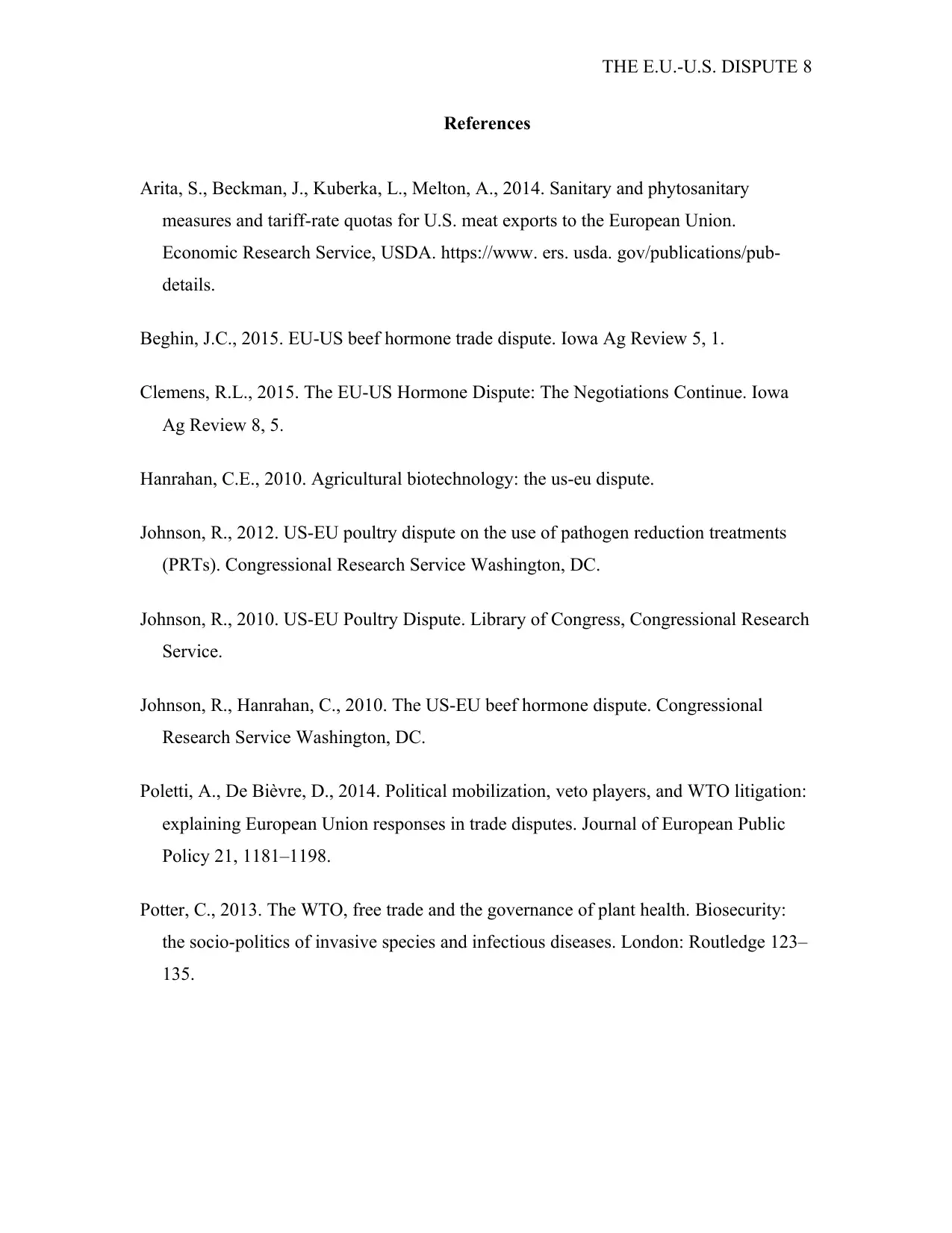
THE E.U.-U.S. DISPUTE 8
References
Arita, S., Beckman, J., Kuberka, L., Melton, A., 2014. Sanitary and phytosanitary
measures and tariff-rate quotas for U.S. meat exports to the European Union.
Economic Research Service, USDA. https://www. ers. usda. gov/publications/pub-
details.
Beghin, J.C., 2015. EU-US beef hormone trade dispute. Iowa Ag Review 5, 1.
Clemens, R.L., 2015. The EU-US Hormone Dispute: The Negotiations Continue. Iowa
Ag Review 8, 5.
Hanrahan, C.E., 2010. Agricultural biotechnology: the us-eu dispute.
Johnson, R., 2012. US-EU poultry dispute on the use of pathogen reduction treatments
(PRTs). Congressional Research Service Washington, DC.
Johnson, R., 2010. US-EU Poultry Dispute. Library of Congress, Congressional Research
Service.
Johnson, R., Hanrahan, C., 2010. The US-EU beef hormone dispute. Congressional
Research Service Washington, DC.
Poletti, A., De Bièvre, D., 2014. Political mobilization, veto players, and WTO litigation:
explaining European Union responses in trade disputes. Journal of European Public
Policy 21, 1181–1198.
Potter, C., 2013. The WTO, free trade and the governance of plant health. Biosecurity:
the socio-politics of invasive species and infectious diseases. London: Routledge 123–
135.
References
Arita, S., Beckman, J., Kuberka, L., Melton, A., 2014. Sanitary and phytosanitary
measures and tariff-rate quotas for U.S. meat exports to the European Union.
Economic Research Service, USDA. https://www. ers. usda. gov/publications/pub-
details.
Beghin, J.C., 2015. EU-US beef hormone trade dispute. Iowa Ag Review 5, 1.
Clemens, R.L., 2015. The EU-US Hormone Dispute: The Negotiations Continue. Iowa
Ag Review 8, 5.
Hanrahan, C.E., 2010. Agricultural biotechnology: the us-eu dispute.
Johnson, R., 2012. US-EU poultry dispute on the use of pathogen reduction treatments
(PRTs). Congressional Research Service Washington, DC.
Johnson, R., 2010. US-EU Poultry Dispute. Library of Congress, Congressional Research
Service.
Johnson, R., Hanrahan, C., 2010. The US-EU beef hormone dispute. Congressional
Research Service Washington, DC.
Poletti, A., De Bièvre, D., 2014. Political mobilization, veto players, and WTO litigation:
explaining European Union responses in trade disputes. Journal of European Public
Policy 21, 1181–1198.
Potter, C., 2013. The WTO, free trade and the governance of plant health. Biosecurity:
the socio-politics of invasive species and infectious diseases. London: Routledge 123–
135.
1 out of 8
Your All-in-One AI-Powered Toolkit for Academic Success.
+13062052269
info@desklib.com
Available 24*7 on WhatsApp / Email
![[object Object]](/_next/static/media/star-bottom.7253800d.svg)
Unlock your academic potential
Copyright © 2020–2025 A2Z Services. All Rights Reserved. Developed and managed by ZUCOL.
